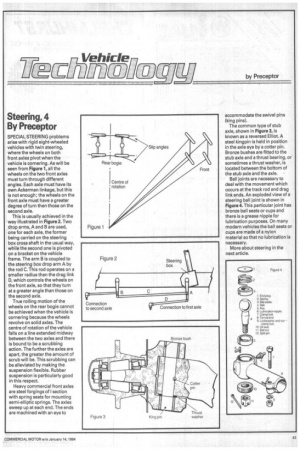Steering, 4 By Preceptor
Page 45

If you've noticed an error in this article please click here to report it so we can fix it.
SPECIAL STEERING problems arise with rigid eight-wheeled vehicles with twin steering, where the wheels on both front axles pivot when the vehicle is cornering. As will be seen from Figure 1, all the wheels on the two front axles must turn through different angles. Each axle must have its own Ackerman linkage, but this is not enough; the wheels on the front axle must have a greater degree of turn then those on the second axle.
This is usually achieved in the way illustrated in Figure 2. Two drop arms, A and B are used, one for each axle, the former being carried on the steering box cross shaft in the usual way, while the second one is pivoted on a bracket on the vehicle frame. The arm B is coupled to the steering box drop arm A by the rod C. This rod operates on a smaller radius than the drag link D, which controls the wheels on the front axle, so that they turn at a greater angle than those on the second axle.
True rolling motion of the wheels on the rear bogie cannot be achieved when the vehicle is cornering because the wheels revolve on solid axles. The centre of rotation of the vehicle falls on a line extended midway between the two axles and there is bound to be a scrubbing action. The further the axles are apart, the greater the amount of scrub will be. This scrubbing can be alleviated by making the suspension flexible. Rubber suspension is particularly good in this respect.
Heavy commercial front axles are steel forgings of I section with spring seats for mounting semi-elliptic springs. The axles sweep up at each end. The ends are machined with an eye to accommodate the swivel pins (king pins).
The common type of stub axle, shown in Figure 3, is known as a reversed Elliot. A steel kingpin is held in position in the axle eye by a cotter pin. Bronze bushes are fitted to the stub axle and a thrust bearing, or sometimes a thrust washer, is located between the bottom of the stub axle and the axle.
Ball joints are necessary to deal with the movement which occurs at the track rod and drag link ends. An exploded view of a steering ball joint is shown in Figure 4. This particular joint has bronze ball seats or cups and there is a grease nipple for lubrication purposes. On many modern vehicles the ball seats or cups are made of a nylon material so that no lubrication is necessary.
More about steering in the next article.








































































